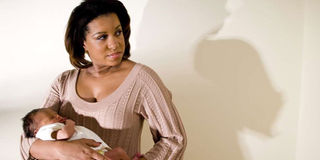BOSIRE: Some truths about breastfeeding

If a new mother does not know how to position the baby to latch properly onto the breast, she will get cracked nipples, which can then lead to mastitis. PHOTO| FILE| NATION
Every mother needs to be supported in every way possible to make the breastfeeding experience as easy as possible.
However, from controversy around breastfeeding in public places to difficulties with breastfeeding in the workplace, mothers are beset with challenges in trying to do what is best for babies.
Mums have found a safe space on social media, where they can share their breastfeeding experiences without fear.
In her classic humorous fashion, Diana Awuor, one of those mothers, talks about waking up in the middle of the night to find herself soaked in milk. But what was particularly bewildering was that the milk was spilling out of her armpits.
She reminded me of the fascinating anatomy classes, during which we learnt about the mammary (milk) line.
When an embryo is growing in the womb, an elevated ridge develops, arching from the armpit, down to the groin, on both sides. This is the line along which breasts develop. The rest of the ridge disintegrates, leaving the normal pair of breasts behind.
This line is present in all mammals and its persistence can be demonstrated in mammals that have more than one pair of teats such as cats and dogs. If the disintegration of the ridge is incomplete, a woman can have extra breasts or extra nipples. These will be dormant but may become active during lactation for some mums.
During routine examination, the doctor will pick them out as incidental findings. It is quite helpful to reassure the mum before she turns to social media “doctors” who will come up with a perplexing and traumatising array of diagnoses, including bewitchment.
Extra breasts or nipples are not much of a concern but it is important to note that the ectopic breast tissue may be the primary site of development of breast cancer.
CRACKED NIPPLES
Alongside the supernumerary (extra) nipples are other acquired breastfeeding complications that may occur during the breastfeeding period.
The commonest is cracked nipples. This happens pretty much almost immediately breastfeeding commences, in the event the new mum does not know how to position the baby to latch properly on to the breast.
By the second or third day, mummy is in tears every time she has to feed the baby. If there was ever an important task for lactation specialists, it is to prevent cracked nipples.
Cracked nipples may be the nightmare of many a new mum, but it can get even worse. Mastitis, an inflammation of the breast tissue secondary to infection, may result from the cracking of the nipples. Bacteria enters the breast tissue causing the breast to become sore, tender and hot to touch.
Coupled with full breasts, it is easy for the mum to miss the early signs of infection, mistaking them for breast engorgement.
Left untreated, mastitis may result in formation of breast abscess. The tissue being destroyed by bacteria dies off and results in accumulated pus. This becomes a surgical emergency.
What starts out as a nurturing experience may take a downward turn that must be quickly halted. Additionally, breast cancer can strike at any moment, including during breastfeeding.
A diagnosis of breast cancer at any time in a woman’s lifetime is traumatising. To have your doctor tell you that your breast biopsy has tested positive for cancer when you have a breastfeeding five-month-old infant is beyond comprehension.
There is no way to prepare a mother for what will lies ahead in the course of treatment.
New mums must be sufficiently empowered to recognise the early signs of mastitis to prevent breast abscesses. If it doesn’t feel right, it probably isn’t. Healthcare providers should take breast complaints seriously and not just write it off as breastfeeding inexperience.
As if waking up to a milk-soaked bed is not enough, Diana brought even more good humour to the group by reminding us just how motherhood has a way of changing all of us in the blink of an eye. From a stylish young lady in touch with trending fashion, to just a mum more concerned with ensuring her baby is fed.
That is what happened when she forgot and wore the wrong dress on the day she was taking her baby to the paediatrician.
The moment her little one started wailing for his meal, she suddenly realised that in her new capacity as an official mobile milk dispenser, her tap was completely inaccessible!
In the end, she found herself walking around in a workman’s overalls, several sizes bigger, procured from a nearby hardware by her husband. At that moment, it did not matter. She was just relieved to be able to breastfeed her baby, oblivious to the stares she was drawing.
Women have worked hard to scale the professional ladder. They have moved on from wearing dreary maternity clothes in the name of motherhood. They carry their pregnancies in comfort and look great while at it.
In the same vein, when their bundles of joy make their arrival, they should still be able to wear breast pads with ease underneath their power suits to the corporate meeting and glide seamlessly into mummy mode when baby demands it.
The expectation is that breastfeeding should be natural and spontaneous. In many instances, this is the case. When this does not happen, we must be empathetic and supportive. Most mothers are juggling so many balls in their life, we must make sure that they do not drop the baby!



